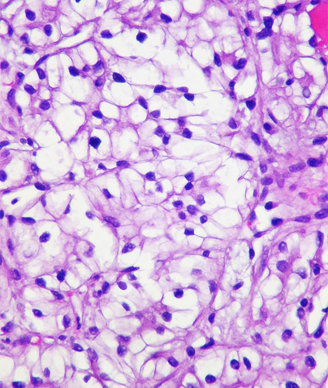Neutrophil-to-Lymphocyte Ratio Linked to mRCC Outcomes
Metastatic renal cell carcinoma patients with an elevated neutrophil-to-lymphocyte ratio at baseline had inferior outcomes compared to those with a low ratio.
Micrograph of metastatic renal cell carcinoma; image © Yale Rosen.

Patients with metastatic renal cell carcinoma with an elevated neutrophil-to-lymphocyte ratio (NLR) at baseline had inferior outcomes compared with patients with a low NLR, showing that NLR may serve as an early biomarker of benefit of targeted therapy, according to the results of a study presented at the 2015 ASCO Genitourinary Cancers Symposium (Abstract 404).
“When adjusted for known prognostic factors in metastatic renal cell carcinoma, a baseline NLR of greater than 3 is an adverse prognostic factor,” said study presenter Nimira S. Alimohamed, MD, FRCPC, of the Tom Baker Cancer Centre in Calgary. “A decrease in NLR from high to low with targeted therapy is associated with favorable outcomes in overall survival, progression-free survival, and response rates, while an increase in NLR with targeted therapy had the opposite effect.”
In this study, NLR was defined as the number of neutrophils, a major component of cancer-related local inflammation, divided by the number of lymphocytes, thought to be suppressors of cancer progression, in peripheral blood.
According to Alimohamed, previous research has shown that NLR is significantly associated with recurrence-free survival in patients with localized renal cell carcinoma undergoing nephrectomy and was an independent prognostic factor for overall survival in patients with non-metastatic renal cell carcinoma. In addition, a small study showed that patients with metastatic disease treated with tyrosine-kinase inhibitors showed an NLR greater than 3 predicted for worse outcomes.
Here, the researchers evaluated two sets of patients. The training set included 1,199 patients with metastatic renal cell carcinoma from the International mRCC Database Consortium (IMDC) who had received targeted therapy and had NLR data available prior to first-line therapy and 6 weeks thereafter. The validation set included 4,350 patients with metastatic renal cell carcinoma treated with targeted therapy in 12 studies conducted or sponsored by Pfizer.
For patients with a higher baseline NLR, an NLR greater than 3, the median overall survival was 14.6 months compared with 28.1 months in patients with a baseline NLR of 3 or less (HR = 1.45; P < .001). Similarly, progression-free survival was inferior in patients with a higher NLR at baseline (6.6 months vs 12.1 months; HR = 1.33; P < .001). All hazard ratios were adjusted for differences in IMDC score.
The researchers replicated their findings in the validation cohort. Again, patients with a higher NLR at baseline had inferior overall survival (12.4 months vs 26.7 months; HR = 1.47; P < .001) and progression-free survival (4.9 months vs 8.5 months; HR = 1.26; P < .001) compared with patients with a lower NLR at baseline.
Next, the researchers looked at the effect of NLR conversation that occurred after 6 weeks of targeted therapy. They found that patients in the training cohort with a high NLR that converted down to 3 or less after 6 weeks of treatment had an overall survival of 21.4 months compared with 9.7 months in patients whose NLR remained greater than 3 (P < .001); this increased overall survival was also seen in the validation cohort (18.2 months vs 10.2 months; P < .001).
Conversely patients who started at baseline with a low NLR and had an up conversation had an inferior overall survival compared with patients whose NLR remained 3 or less (14.3 months vs 30 months; P < .001); these results were replicated in the validation cohort (17.3 months vs 29.6 months; P < .001).
Newsletter
Stay up to date on recent advances in the multidisciplinary approach to cancer.